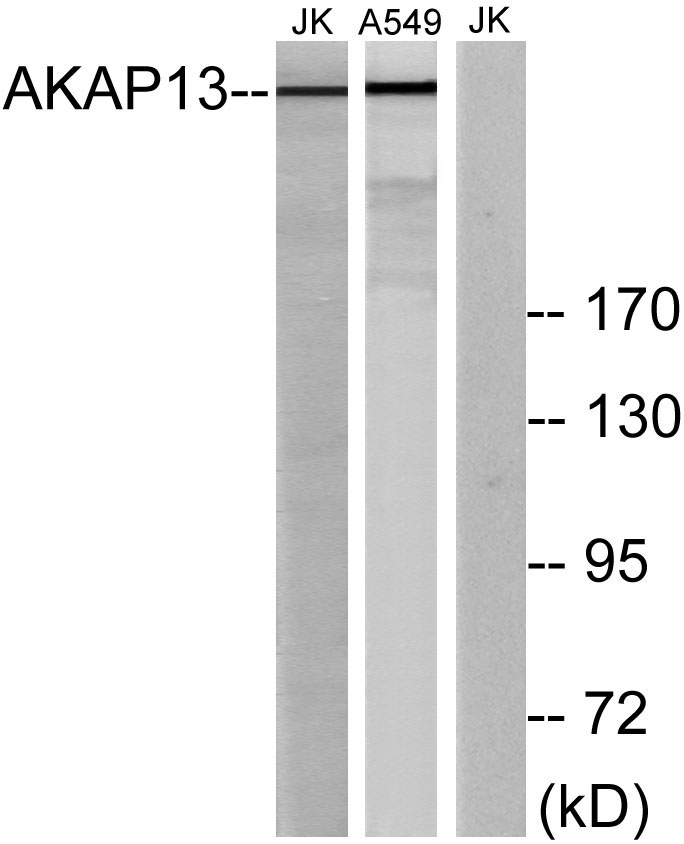AKAP 13 Polyclonal Antibody
- Catalog No.:YT0161
- Applications:WB;IHC;IF;ELISA
- Reactivity:Human;Rat;Mouse;
- Target:
- AKAP 13
- Fields:
- >>Parathyroid hormone synthesis, secretion and action;>>Human cytomegalovirus infection
- Gene Name:
- AKAP13
- Protein Name:
- A-kinase anchor protein 13
- Human Gene Id:
- 11214
- Human Swiss Prot No:
- Q12802
- Immunogen:
- The antiserum was produced against synthesized peptide derived from human AKAP13. AA range:721-770
- Specificity:
- AKAP 13 Polyclonal Antibody detects endogenous levels of AKAP 13 protein.
- Formulation:
- Liquid in PBS containing 50% glycerol, 0.5% BSA and 0.02% sodium azide.
- Source:
- Polyclonal, Rabbit,IgG
- Dilution:
- WB 1:500 - 1:2000. IHC 1:100 - 1:300. ELISA: 1:20000.. IF 1:50-200
- Purification:
- The antibody was affinity-purified from rabbit antiserum by affinity-chromatography using epitope-specific immunogen.
- Concentration:
- 1 mg/ml
- Storage Stability:
- -15°C to -25°C/1 year(Do not lower than -25°C)
- Other Name:
- AKAP13;BRX;HT31;LBC;A-kinase anchor protein 13;AKAP-13;AKAP-Lbc;Breast cancer nuclear receptor-binding auxiliary protein;Guanine nucleotide exchange factor Lbc;Human thyroid-anchoring protein 31;Lymphoid blast crisis oncogene;LBC
- Observed Band(KD):
- 307kD
- Background:
- The A-kinase anchor proteins (AKAPs) are a group of structurally diverse proteins which have the common function of binding to the regulatory subunit of protein kinase A (PKA) and confining the holoenzyme to discrete locations within the cell. This gene encodes a member of the AKAP family. Alternative splicing of this gene results in multiple transcript variants encoding different isoforms containing c-terminal dbl oncogene homology (DH) and pleckstrin homology (PH) domains. The DH domain is associated with guanine nucleotide exchange activation for the Rho/Rac family of small GTP binding proteins, resulting in the conversion of the inactive GTPase to the active form capable of transducing signals. The PH domain has multiple functions. Therefore, these isoforms function as scaffolding proteins to coordinate a Rho signaling pathway, function as protein kinase A-anchoring proteins and, in addi
- Function:
- caution:The sequence shown here is derived from an Ensembl automatic analysis pipeline and should be considered as preliminary data.,domain:Both the DH and PH domains are required for transforming activity.,function:Anchors cAMP-dependent protein kinase (PKA) and acts as an adapter protein to selectively couple G alpha-13 and Rho. Augments gene activation by the estrogen receptor in an element-specific and ligand-dependent manner. Activates estrogen receptor beta by a p38 MAPK-dependent pathway. Isoform 6 stimulates exchange activity on Rho proteins in vitro, but not on CDC42, Ras or Rac and may bind calcium ions.,similarity:Contains 1 DH (DBL-homology) domain.,similarity:Contains 1 PH domain.,similarity:Contains 1 phorbol-ester/DAG-type zinc finger.,subunit:Binds cAMP-dependent protein kinase (PKA) and to the RII-alpha regulatory subunit of PKA. Interacts with ESR1, ESR2, THRA, PPARA, R
- Subcellular Location:
- Cytoplasm, cytosol . Cytoplasm . Cytoplasm, cell cortex . Nucleus . Membrane ; Peripheral membrane protein . Colocalizes with the actin cytoskeleton at the cell cortex. .
- Expression:
- Detected in mammary gland (PubMed:9627117). Detected in heart (at protein level) (PubMed:11546812). Expressed as a 5.3 kb transcript in hematopoietic cells, skeletal muscle, lung, heart, estrogen-responsive reproductive tissues, including breast ductal epithelium. Also found in testis and breast cancer cell lines. Predominantly expressed as a 10 kb transcript in the heart and at lower levels in the lung, placenta, kidney, pancreas, skeletal muscle and liver. Transcripts of between 6-9 kb are also expressed in myeloid and lymphoid lineages, a variety of epithelial tissues, and in skeletal muscle.
MiR-629-5p Promotes Prostate Cancer Development and Metastasis by Targeting AKAP13. Frontiers in Oncology Front Oncol. 2021; 11: 754353 WB Human LNCaP cell, PC3 cell,C4-2 cell
- June 19-2018
- WESTERN IMMUNOBLOTTING PROTOCOL
- June 19-2018
- IMMUNOHISTOCHEMISTRY-PARAFFIN PROTOCOL
- June 19-2018
- IMMUNOFLUORESCENCE PROTOCOL
- September 08-2020
- FLOW-CYTOMEYRT-PROTOCOL
- May 20-2022
- Cell-Based ELISA│解您多样本WB检测之困扰
- July 13-2018
- CELL-BASED-ELISA-PROTOCOL-FOR-ACETYL-PROTEIN
- July 13-2018
- CELL-BASED-ELISA-PROTOCOL-FOR-PHOSPHO-PROTEIN
- July 13-2018
- Antibody-FAQs
- Products Images

- Immunohistochemistry analysis of paraffin-embedded human heart tissue, using AKAP13 Antibody. The picture on the right is blocked with the synthesized peptide.

- Western blot analysis of lysates from Jurkat and A549 cells, using AKAP13 Antibody. The lane on the right is blocked with the synthesized peptide.



